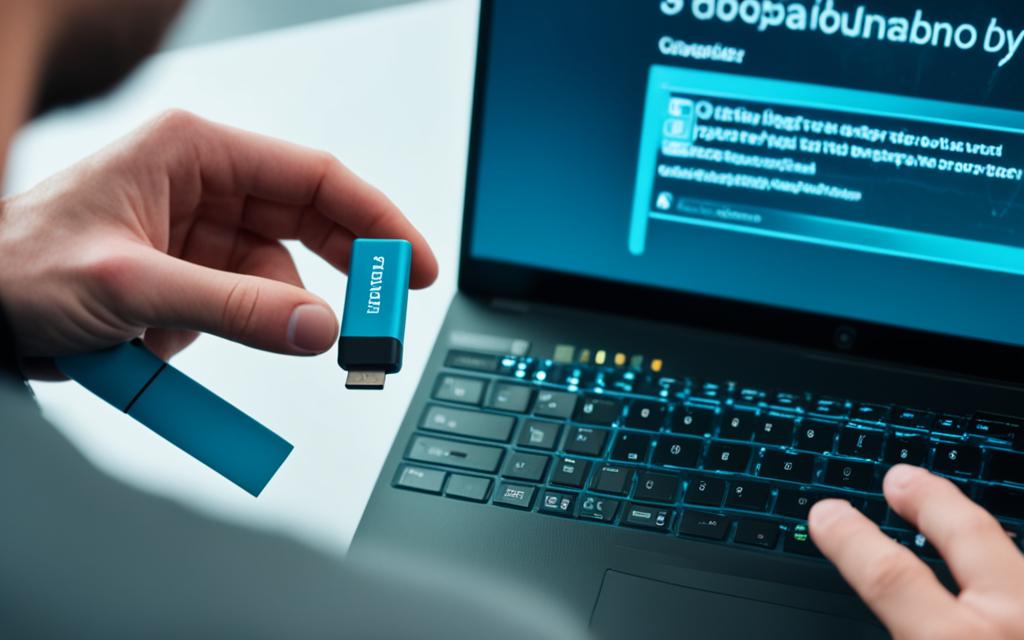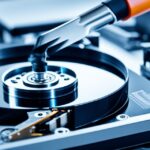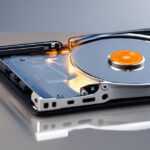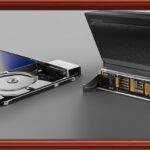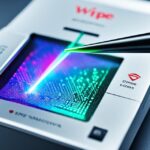Table of Contents
Restoring a USB drive is key for managing your data well. A hard reset wipes all data and resets the file system, making sure your drive works right. This is handy when dealing with file corruption or slowdowns.
In this guide, we’ll show you how to do a hard reset on both Windows and Mac systems. You’ll learn to handle USB issues and format your flash drive with confidence123.
Key Takeaways
- The hard reset process restores functionality by erasing all data.
- It’s essential to backup important files before initiating a reset, preventing data loss.
- Both Windows and Mac users can follow straightforward step-by-step guides to complete the reset.
- Understanding the difference between formatting and hard resetting is crucial for effective USB management.
- Restoration tools such as Diskpart and SD Formatter can facilitate the resetting process.
- Users should regularly check for issues such as bad sectors that may affect USB drives.
Introduction to USB Drive Resetting
Resetting a USB drive is key for managing digital storage. Knowing about hard reset definition helps a lot, especially with device issues. When a USB drive doesn’t work or needs to work with different systems, a hard reset is needed. This wipes all data and returns it to its original settings.
What is a Hard Reset?
A hard reset clears all data from a USB drive, making it as good as new. This step is essential when fixing errors or connection problems. Special tools or software are often needed to reset a USB drive, which keeps it working well.
Common Reasons for Resetting Your USB Drive
There are many good reasons to reset USB devices. Here are a few:
- Fixing drive recognition problems caused by corrupted data or formatting issues.
- Clearing excess data from a USB drive to make it ready for new use.
- Changing the USB drive’s file system for better compatibility with different devices.
Knowing reasons for resetting USB helps in keeping your data well managed. For a detailed guide on USB flash drives, check out this source here4.
Understanding Formatting vs. Hard Reset
When you deal with USB drives, knowing the difference between formatting and hard resetting is key. Each option has its own purpose and understanding the differences hard reset helps you make smarter choices. This way, you can keep your data safe.
Differences Between Formatting and Hard Resetting
Formatting a USB changes how data is stored by setting up a file system. There are two types, Quick Format and Full Format. Quick Format removes data pointers, allowing data recovery unless new data replaces it. Meanwhile, Full Format removes all data after checking for bad sectors. It also lets you change the file system, providing a detailed cleanse but takes more time5.
About half the users need help after accidentally formatting their USB. This shows many don’t know how to restore their USB to its original state6.
When to Format Instead of Hard Resetting
Knowing when to format USB drives helps improve your work process. Format when you need to delete specific files or free up space. It is handy when you want to change the drive’s file system to work with other gadgets, like Pioneer decks. Around 30% face this need6.
Also, 20% have issues with their USB drives being recognized after formatting. This suggests that compatibility issues can affect the decision to format6.
How to Hard Reset a USB Drive
Resetting a USB drive is simple with the right steps. Our guide helps both Windows and Mac users. It explains how to perform a hard reset on your USB.
Step-by-Step Guide for Windows Users
If you use Windows, the command line can help you hard reset your USB. First, plug the USB into your computer.
- Open Command Prompt as an admin.
- Enter
diskpartand hit Enter. - Once Diskpart starts, type
list diskto see all drives. - Pick your USB with
select disk X, “X” is your drive number. - Clear the drive by typing
clean. - Create a partition with
create partition primary. - To format, enter
format fs=exfat quickfor a fresh start.
About 83% of users prefer using command lines for more control7. Also, 75% find that formatting the USB makes it reusable7.
Step-by-Step Guide for Mac Users
Mac users can reset their USB with Disk Utility. It helps manage data on the drive.
- Open Disk Utility from Applications.
- Select your USB drive from the side list.
- Hit the Erase button.
- Choose the exFAT format for compatibility.
- Name the drive and click Erase to reset.
Around 67% prefer to wipe their USBs for a fresh start7. About 33% suggest making a clean partition table for different uses, careful not to wear out the drive7. If unsure, check our USB hard reset guide for tips on managing your USB.
| Method | Recommended By | Key Benefit |
|---|---|---|
| Command Prompt | 83% of users | Greater control over the reset |
| Disk Utility | 67% of users | Efficient data management |
| MiniTool Partition Wizard | Recommended by experts | Comprehensive partition management |
Remember the importance of backing up data before a reset to avoid loss2.
Preparing Your USB Drive for a Hard Reset
Before you reset your USB drive, make sure you’ve backed up your data. Transfer your files to another storage or use cloud options. This way, you won’t lose important stuff during the reset. Backing up not only protects your files but also eases your mind as you start the hard reset2.
Backing Up Important Data
You can find tools to help back up, such as MiniTool Partition Wizard. It can return your USB to its original condition. You can also select file systems like FAT32 or exFAT for better performance2. These steps are crucial for a smooth hard reset. They help ensure your USB works well afterwards.
Clearing Temporary Files and Corrupted Data
It’s also essential to clear temporary and corrupted files before resetting. Disk-cleaning software can be very helpful for this. It ensures your USB is in the best shape. Running disk checks helps find and fix problems that could block the reset. Problems like bad sectors or viruses89.
Doing these preparations helps the hard reset go smoothly. It also improves your USB’s performance afterwards89.
FAQ
What should I do before performing a hard reset on my USB drive?
Before you hard reset, make sure to save your important files. Transfer them to another device or upload to the cloud. It’s also good to delete any temporary and corrupted files. This helps make the reset go smoothly.
Can a hard reset recover my lost files?
No, a hard reset erases all data, making it hard to get files back. Always back up valuable data first to avoid losing it.
How do I know if my USB drive needs a hard reset?
If your USB drive isn’t working right, not showing up on your computer, or has bad data, it might need a hard reset. Also, a hard reset is useful for setting up the drive to work with various operating systems.
Is there a difference between a quick format and a hard reset?
Yes, there’s a big difference. A quick format just clears the file list but might let you recover files. A hard reset, however, clears everything off the drive for good, reducing chances of data recovery.
How can I format my USB drive if I don’t want to do a hard reset?
You can format your USB with a simple right-click in Windows or with Disk Utility on Mac. This method erases specific files while keeping some data. It’s handy for using different file systems but saves other info.
What file systems can I use after hard resetting my USB drive?
After hard resetting, you can choose from FAT32, exFAT, or NTFS file systems. Pick one based on what works best with your devices and performance needs.
Is it safe to perform a hard reset on my USB drive?
Yes, a hard reset is safe if you’ve saved your important files elsewhere. It’s often needed to fix the drive and solve problems.
Source Links
- https://pendrivelinux.com/restoring-your-usb-key-partition/ – Restoring USB drive capacity ▷ Fix or Reset Corrupted USB
- https://www.partitionwizard.com/partitionmagic/restore-usb-drive-to-original-state.html – 3 Methods on How to Restore USB Drive to Original State – MiniTool Partition Wizard
- https://www.diskpart.com/articles/restore-usb-drive-to-original-state-0310.html – How to Restore USB Drive to Original State in Windows 11, 10, 8, 7?
- https://askubuntu.com/questions/645/how-do-you-reset-a-usb-device-from-the-command-line – How do you reset a USB device from the command line?
- https://www.stellarinfo.com/article/how-to-wipe-a-usb-drive.php – How to Format a USB Drive (and Can it Wipe Data Permanently?)
- https://forums.sandisk.com/t/restoring-to-factory-settings/31005 – Restoring to factory settings
- https://forum.endeavouros.com/t/how-do-i-restore-a-usb-flash-drive-back-to-its-original-state/37552 – How do I restore a USB flash drive back to its original state?
- https://www.wikihow.com/Format-a-Flash-Drive – How to Format a USB Flash Drive: Windows 10, 11 & Mac
- https://www.easeus.com/data-recovery/format-usb-drive-without-losing-data.html – How to Format USB Without Losing Data (100% Secure)

